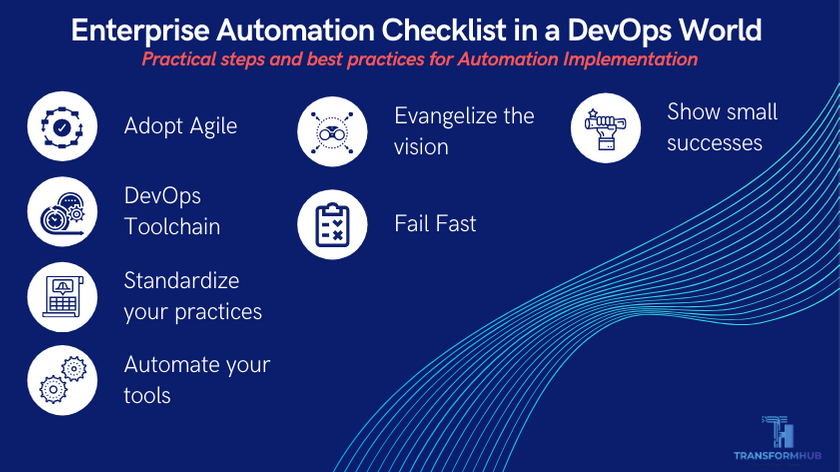Reduce time to market with CI/CD Release Automation
In a day and age where business continuity and profitability mean everything, enterprises are moving away from traditional methods of calculating ROI. They can no longer afford to overlook the fluidity of today's market and need to factor in the changes that occur by the time a product is actually released and deployed into the market. Profitability, therefore, is now not just about calculating ROI but also estimating the time-to-market for a product.
This approach has numerous advantages. It helps you stay ahead of market change and achieve many other objectives along the way. Some of these include better progression and quicker adjustments.
Having discussed the many elements that go into DevOps in our previous blog, we now move on to understand how the Continuous Integration / Continuous Deployment (CI/CD) helps accelerate a product's time to market and the role played by release automation.
Understanding why CI/CD is a primer for enterprises
Knowing why you implement the CI/CD goes a long way in explaining its role. CI and CD are more like force multipliers and the right implementation will reap rich dividends for the enterprise. Not to forget the immense time it will save in rolling out new features.
In a culture of collaboration and co-ownership, CI and CD are the backbones of the sophisticated DevOps environment. While CI enables testing automation to ensure that the application is not broken during implementation changes, CD streamlines and automates every process that’s part of the deployment.
What follows is a chain of timely and consistent enhancements in the process of development and deployment that in turn speeds up the time to market of products. This is where product engineering services come handy. With their assistance, bugs are fixed early on, validation takes little time and processes are orchestrated and automated easily, thanks to modern cloud technologies. The monitoring dashboard for the production environment gives a clear perspective on things and helps eliminate performance bottlenecks.
Consolidated efforts across departments go a long way in boosting processes at various junctures of delivery. CI and CD in conjunction help enterprises develop and deliver high-quality software quickly and efficiently. Their implementation helps speed up delivery times and ensures faster time-to-market.
Release Automation
As more and more enterprises adopt DevOps practices, accelerating product cycles remains a core objective. Of course, there are quite a few benefits of release automation. The top ones include enhancing agility and flexibility across departments while improving productivity and reducing manual tasks. From orchestration and packaging to dependencies and approvals, application release automation solutions must factor in the many interactions between the product and the systems it relies on.
In the wake of COVID-19, there is going to be an unprecedented demand for automation solutions. Explains Alessandro Perilli, GM, Management Strategy, Red Hat, "The current situation requires a return on the investment faster than ever. And you cannot realize a return on the investment very quickly if you focus on one big process with many complex sub-processes that have never been standardized or automated before."
Enterprises will be compelled to protect themselves more aggressively to reduce their exposure to future business disruption. According to a new report from Forrester, "As we emerge from the crisis, firms will look to automation as a way to mitigate the risks that future crises pose to the supply and productivity of human workers. They will invest more in cognitive capabilities and applied AI, industrial robotics, service robots, and robotic process automation (RPA)."
An enterprise-wide automation strategy helps organizations refine existing processes and execute them upon digital transformation. Ultimately, employing modern automation in an enterprise application environment helps a business serve its customers better —so organizations can be successful in the digital economy.

Fig: RedHat- Enterprise Automation checklist
Let us understand the enterprise automation checklist in a DevOps World, its practical steps and best practices for Automation Implementation in detail.
- Adopt Agile: The pre-requisite for successful automation is the adoption of agile methodologies and scrum teams.
- Evangelize the vision: Take time to share information and demos throughout the organization to create awareness about automation and prove its value.
- Show small successes: Start small, automate something, but do not try to automate many things in one release.
- DevOps toolchain: Wherever you are in the evolution from waterfall to agile methodologies and practices, pay attention to your DevOps toolchain. Hire an IT services provider to offer DevOps consulting services, and flush it out with you.
- Fail Fast: Fail fast by continually moving tests as early in the process as possible so that failures can be detected early and fixed at a lower cost. Cost of failure based on the phase it is caught in.
- Standardize your practices: Standardize your playbooks, roles, and other automation practices. It helps to maintain a clean, readable, manageable, and stable code.
- Automate your tools: Develop your Infrastructure as Code (IaC) so that it can be easily managed.
Choosing the best-of-breed tools
While choosing the best application release automation tools, it is important to choose the ones that offer a wide range of capabilities that enable better pipeline management, environment provisioning, and an appropriate test automation framework. As reported by Globe Newswire, the application release automation market globally is expected to grow by US$5.5 billion with a compounded growth of 20.8%.
The best automation tools are expected to offer integrated functionality along with software tracking and reporting features. As always, the solution you choose should be scalable, adaptable, and reusable to meet the changing needs of your business.
We’ve handpicked a few you may want to consider.
- Ansible - Red Hat Ansible has garnered a lot of popularity for the incredible business values it offers including agility, better control, and compliance, lower infrastructure cost, and higher replication speed of scalability.
- Chef - It's fast, scalable, flexible, and relies on 'recipes' in the form of instructions for web-server configuration, databases, and load balancers.
- Kubernetes - Its ability to run containers in a cluster and monitor applications across different containers makes it very versatile. Also, this open-source tool can be easily used in public, private, hybrid, and multi-cloud environments.
- Puppet - The cross-platform, open-source Puppet enhances manageability and productivity through in-depth reports and real-time alerts that help teams to remediate issues immediately.
- Docker - The lightweight, container technology based Linux platform Docker comes with powerful functionalities and features that allow users to build applications securely both on-premises and in the cloud environment.
- Jenkins - it offers myriad plugins that speed up building, deployment, and automation of the complete lifecycle of a software project. It's also popular for its pipeline feature that makes everything easier right from automatically committing code into the repository to running test cases and obtaining reports post-testing.
- Vagrant - It helps members manage everything in a single workflow - be it sharing software running environment or testing applications. It ensures consistency in the environment across all machines.
- TeamCity - Ideal for those using continuous integration, it enables teams to run multiple builds and tests under different configurations and platforms simultaneously.
- Maven - This tool also offers a uniform build system saving ramp-up time for new developers. Its project object model (POM) makes chores like automatic updating and dependency closures easy.
- Gradle - This tool comes in handy while building complex and/or distributed applications. It simplifies the build process and helps build, automate, and deliver faster.
Do more with less - Culture of Automation
Global dynamics are shifting at a phenomenal pace and a simple automation language is just what we need. Every tool comes with its pros and cons. We need to choose one that fits best with our requirements. The Key is doing more with less by automating everything possible.
At TransformHub - the digital transformation company, the onus is on us to help organizations get started on their journey towards automation and digital transformation. Your goals are our focus and we look forward to enhancing your work environment with diverse solutions that have incredible capabilities. For the tools mentioned above or more, you can always rely on our digital transformation services.
Call us for a detailed analysis of your business environment. Our IT consulting services and IT solutions are curated just as per the needs of your business. You are just a call away from the power to do more.
Share this
You May Also Like
These Related Stories

Identify Threats & Opportunities With TransformHub's Market Research Services

Open Banking APIs - Driving the future of the banking sector




